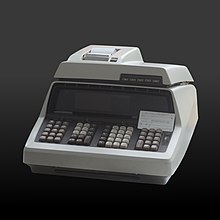Hewlett-Packard 9100A
The Hewlett-Packard 9100A (hp 9100A) is an early programmable calculator[3] (or computer), first appearing in 1968. HP called it a desktop calculator because, as Bill Hewlett said, "If we had called it a computer, it would have been rejected by our customers' computer gurus because it didn't look like an IBM. We therefore decided to call it a calculator, and all such nonsense disappeared."[1]
An ad for the 9100A in 1968 Science magazine contains one of the earliest documented use (as of 2000) of the phrase personal computer.[2]
History[]

The unit was descended from a prototype produced by engineer , who joined the company when HP decided to adopt the project.[4][5][6]
An engineering triumph at the time, the logic circuit was produced without any integrated circuits, the assembly of the CPU having been entirely executed in discrete components. With CRT readout, magnetic card storage, and printer, the price was around $5,000 ($37,000 today).[7]
The 9100A was the first scientific calculator by the modern definition, i.e., capable of trigonometric, logarithmic (log/ln), and exponential functions, and was the beginning of Hewlett-Packard's long history of using Reverse Polish notation (RPN) entry on their calculators.
Due to the similarities of the machines, Hewlett-Packard was ordered to pay about $900,000 in royalties to Olivetti after copying some of the solutions adopted in the Programma 101, like the magnetic card and the architecture.[8][9]
See also[]
References[]
- ^ a b "History of the 9100A desktop calculator, 1968". Hewlett-Packard. Retrieved 2009-12-18.
- ^ a b Aaron, Clark (Dec 2000). "Wired 8.12: Must Read: The First PC". Archived from the original on 2015-10-04. Retrieved 2015-10-04.
- ^ See Old Calculator Museum definition at the end of cited page (note with asterisk)
- "Note in: WANTED - Data Acquisition Corp. DAC-512". www.oldcalculatormuseum.com. Note with asterisk at the end.
- ^ "Osborne's Story". HP9825.com. Retrieved 2010-05-11.
- ^ "How the Model 9100A Was Developed", Bernard M. Oliver, September 1968, Hewlett-Packard Journal]
- ^ 1994 letter from Tom Osborne to Barney Oliver, hp9825.com
- ^ 1634–1699: McCusker, J. J. (1997). How Much Is That in Real Money? A Historical Price Index for Use as a Deflator of Money Values in the Economy of the United States: Addenda et Corrigenda (PDF). American Antiquarian Society. 1700–1799: McCusker, J. J. (1992). How Much Is That in Real Money? A Historical Price Index for Use as a Deflator of Money Values in the Economy of the United States (PDF). American Antiquarian Society. 1800–present: Federal Reserve Bank of Minneapolis. "Consumer Price Index (estimate) 1800–". Retrieved 2020-01-01.
- ^ "Olivetti Programma P101/P102". Old Computers. Archived from the original on 2016-06-09. Retrieved 2010-08-11.
The P101, and particularly the magnetic card, was covered by a US patent (3,495,222, Perotto et al.) and this gave to Olivetti over $900.000 in royalties by HP alone, for the re-use of this technology in the HP9100 series.
- ^ Perotto, Pier Giorgio (1970-02-10). "3,495,222 Program Controlled Electronic Computer" (multiple). United States Patent and Trademark Office. et al. Google patents. Retrieved 2010-11-08.
External links[]
- "HP 9100A Calculator (marketing brochure)" (PDF). Hewlett-Packard. 1968. Retrieved 2013-01-26. Hosted at the Computer History Museum.
- "HP 9100A/B". The Museum of HP Calculators. Retrieved 2013-01-26.
- Bell, C. Gordon; Newell, Allen (1971). "Chapter 20: The HP Model 9100A computing calculator". Computer Structures: Readings and Examples. McGraw-Hill. p. 243. ISBN 0-07-004357-4. Retrieved 2009-12-18.
- Steven Leibson interview of Tom Osborne
- Computer hardware stubs
- HP programmable calculators
